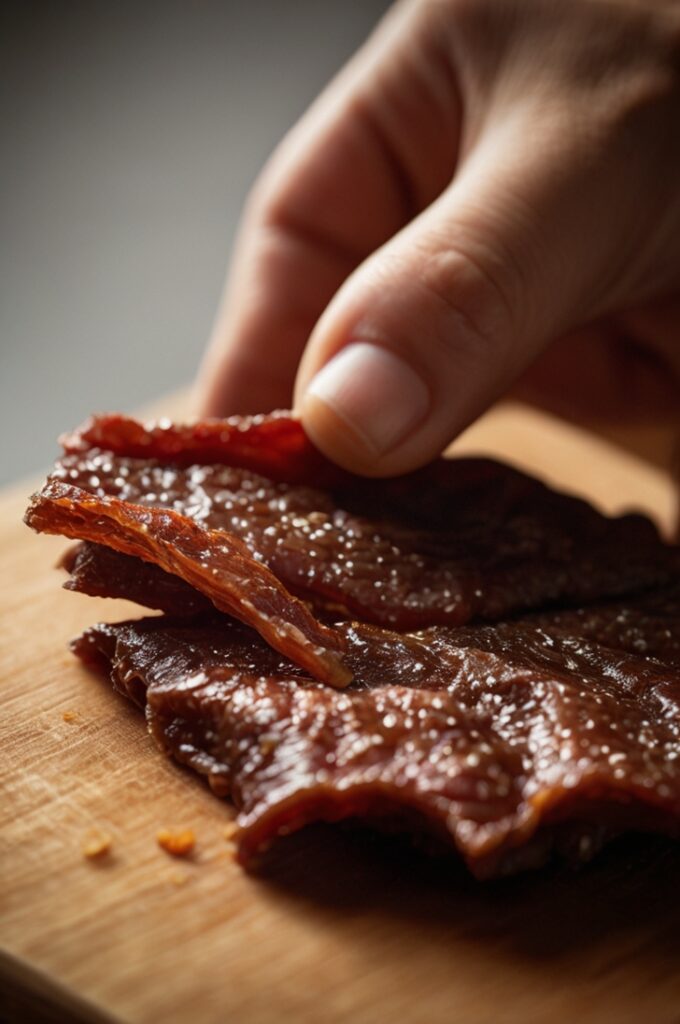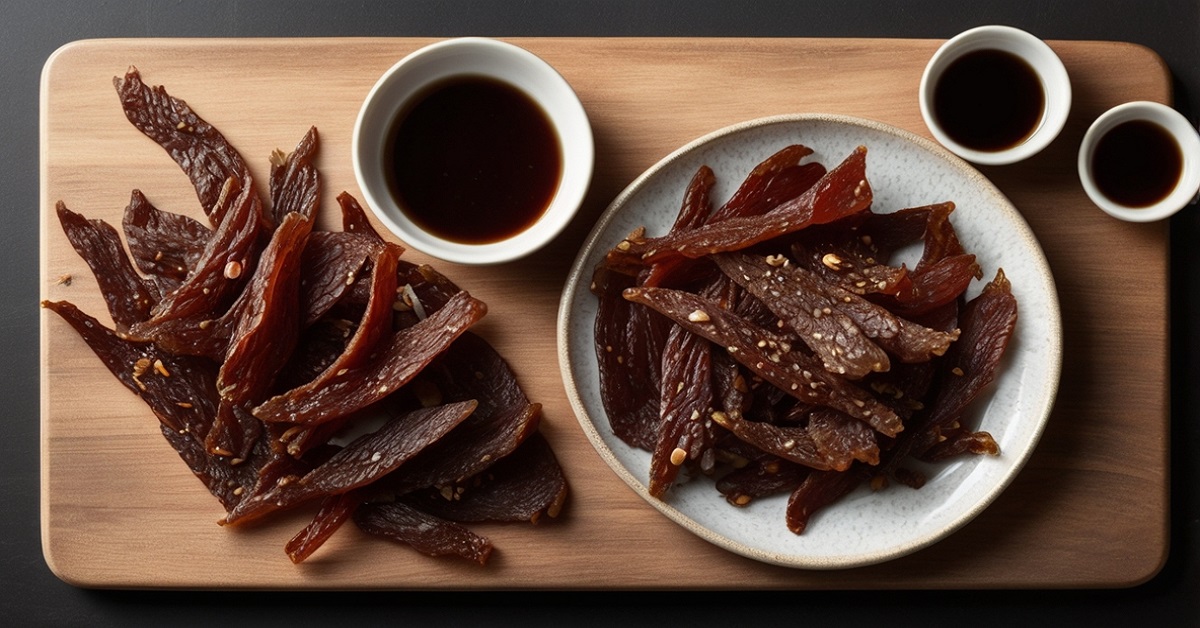I still remember the first time I tasted Homemade Chinese Beef Jerky Recipe magic even though it wasn’t homemade at all. I was about ten, and my uncle pulled a vacuum-packed slab out of his carry-on from Hong Kong.
It smelled like soy sauce and brown sugar and five-spice, and I swear the entire car was wrapped in this smoky, meaty perfume for hours. Chewed on it the whole drive home. Thought about it for days.
This isn’t your gas station jerky. This is something else entirely sweet, salty, umami-loaded slices of marinated beef, dried low and slow until it’s just bendy, just chewy, never dry. Real Chinese beef jerky has depth. It tastes like memory and midnight snacks and home.
And today? We’re making it from scratch.
This Homemade Chinese Beef Jerky Recipe hits that balance of bold flavor and chewy texture. It leans into the Cantonese-style preparation, with a marinade packed full of soy, Shaoxing wine, sugar, and five-spice. And unlike many Western-style jerky recipes, we don’t go heavy on smoke or heat we let the meat speak.
There’s science in the drying, culture in the spice, and soul in the bite. If you’ve only had the vacuum-sealed stuff? You’re in for a treat that blows the commercial versions clean off the cutting board.
Ingredients & Substitutions

Start with lean beef. Top round is the classic pick. Eye of round works, too. Don’t use anything fatty it’ll go rancid quicker.
- 2 lbs beef top round or eye of round, trimmed
- 3 tbsp light soy sauce – Not dark soy. This one adds salt and umami without staining the beef too dark.
- 1.5 tbsp dark soy sauce – Just a little, for color and depth.
- 2 tbsp Shaoxing wine – Can swap with dry sherry if you’re out. Mirin? Too sweet, not quite right.
- 4 tbsp brown sugar – Packed tight. You want that molasses base.
- 1 tsp Chinese five-spice powder – Warm, heady, key. Don’t skip this. Ever.
- 1/2 tsp white pepper – Slight heat, background note.
- 1/2 tsp garlic powder
- 1/2 tsp onion powder
- Optional: 1 tsp chili flakes – If you like a lil’ fire with the sweet.
Substitutions? Sure.
Gluten-free? Use tamari instead of soy sauce. No Shaoxing? Go with dry sherry. No beef? Try venison, but reduce marinade time wild game absorbs flavors faster.
Always slice meat against the grain. You’ll thank yourself later. It chews cleaner.
Step-by-Step Instructions
1. Slice the Beef
Freeze your beef for 45 mins first. Not solid, but firm. Makes slicing easier.
Cut into 1/8- to 1/4-inch slices. Not paper thin. Not steak-thick. Think bacon. Too thick and you’ll be drying for a week. Too thin and it turns into shoe leather.
Always cut against the grain it shortens the muscle fibers and gives that tender-but-chewy bite.
2. Make the Marinade
Mix everything in a large bowl: soy sauces, Shaoxing wine, sugar, five-spice, white pepper, garlic and onion powders. Add chili if you’re using.
Stir until sugar dissolves. Smell it. Should hit sweet and savory all at once. If it doesn’t, something’s off.
3. Marinate the Beef
Dump the sliced beef in. Toss well, use your hands. Get messy.
Cover and refrigerate at least 12 hours, preferably 24. Stir once or twice if you remember. More contact, more flavor.
4. Dry the Jerky
Option A: Oven Drying (Recommended)
Preheat oven to 175°F (80°C). Line baking sheets with wire racks. Lay beef slices flat, no overlaps.
Bake with oven door cracked use a wooden spoon to prop it open. You need moisture to escape.
Dry for 3–4 hours, flipping once. Edges should be dry, center slightly flexible. It darkens and tightens as it cools.
Option B: Dehydrator
Set to 160°F (71°C). Dry 3–5 hours, depending on thickness. You’ll get more even texture, but slightly less caramelization.
Don’t crank the heat. High temps cook it instead of drying it. That’s how you end up with jerky that snaps like stale toast.
Cooking Techniques & Science
This jerky isn’t smoked or grilled. It’s marinated and dried two very different things.
The soy sauce injects salt deep into the fibers, acting as a preservative. Shaoxing wine helps mask any overly “gamey” notes and adds a subtle acidity. Brown sugar caramelizes as it dries, giving those sticky edges and that signature Chinese-style lacquered look.
Five-spice is the real flavor driver star anise, cloves, cinnamon, fennel, and Sichuan pepper. It’s sweet, floral, peppery, and a little weird in the best way.
Drying at a low temp dehydrates without fully cooking. That’s why the beef remains chewy and moist in the center. Crack the oven so the moisture escapes closed ovens just steam the meat. Nobody wants jerky soup.
Use a rack, not just parchment. Air needs to circulate around the meat to dry it evenly.
Tools that Help:
- A dehydrator: more consistent than an oven. No cracking doors. Less checking.
- A wire cooling rack: lets airflow hit all sides.
- A meat slicer (if you’re serious): guarantees even pieces.
- And yes a digital scale for consistent seasoning. Eyeballing gets you a batch that’s too salty one week, bland the next.
Serving & Pairing Suggestions
Let the jerky cool completely. Then stash it in an airtight container. Room temp for a week. Fridge for 2–3. Freeze if you must, but it’ll lose a bit of texture.
Serve it solo? Of course. It’s the kind of snack you chew while standing in the kitchen with a glass of cold tea.
But it also works on a charcuterie board seriously with pickled mustard greens, sesame crackers, and a little dab of hoisin.
Pair it with:
- Oolong tea – roasted, not floral. That dark toasty note plays well.
- Tsingtao or a crisp lager – classic beer snack in Chinese bars.
- Hot rice – chopped into slivers and mixed with scallions and soy, it becomes a quick topping for congee or white rice bowls.
Why It’s Special

Chinese beef jerky doesn’t punch you in the face with heat or smoke. It’s layered umami, sweet, savory, a hint of floral spice.
It’s not mass-produced stuff that tastes like every other bag. It’s personal. Each bite feels handmade. And it keeps well, travels well, and satisfies some primal need to gnaw on something real.
The texture? Just right. A gentle tug with the teeth. None of that fibrous dry-lung horror from overcooked jerky sticks.
And the smell? If your house doesn’t smell like a Cantonese snack shop for a day after drying, you probably didn’t add enough five-spice.
FAQs About Homemade Chinese Beef Jerky Recipe
1. Can I use pork or chicken instead of beef?
Technically yes, but be careful chicken and pork need to reach higher internal temps for safety. Also, they tend to dry out faster. Pork loin is your best bet if subbing.
2. How long does homemade Chinese beef jerky last?
Stored airtight in the fridge, up to 3 weeks. In the pantry, about 7 days. Always sniff and inspect. When in doubt, toss it out.
3. Can I make it sugar-free?
Sort of. You can sub monk fruit or erythritol blends, but you’ll lose the caramelization. Flavor will be different. Still good but not quite classic.
4. Why do I need to slice against the grain?
Because no one wants jerky that fights back. Slicing against the grain shortens the muscle fibers and makes for easier chewing. With-the-grain jerky is stringy and exhausting.
5. Do I need a dehydrator?
Nope. Oven works just fine just crack the door and watch it close. If you’re doing big batches often, a dehydrator is worth the cash.
This is the jerky your aunt kept hidden in the back of the pantry. The one that disappeared in minutes when guests came over. It’s more than a snack it’s a ritual. A little slice of memory, chewy and fragrant and full of quiet joy.
And now? It’s yours to make.
Final Tips & Troubleshooting
Too salty? Cut back on the light soy next round or soak the slices in water for 10 mins before drying.
Too soft? Dry longer. Watch closely every oven’s a little different.
Too sweet? Drop the sugar by a tablespoon. Or switch from dark brown to light.
Want more bite? Add chili oil to the marinade instead of flakes. The oil clings and adds fat-soluble flavor.
Don’t skip the overnight rest. That’s where the flavor magic happens.




